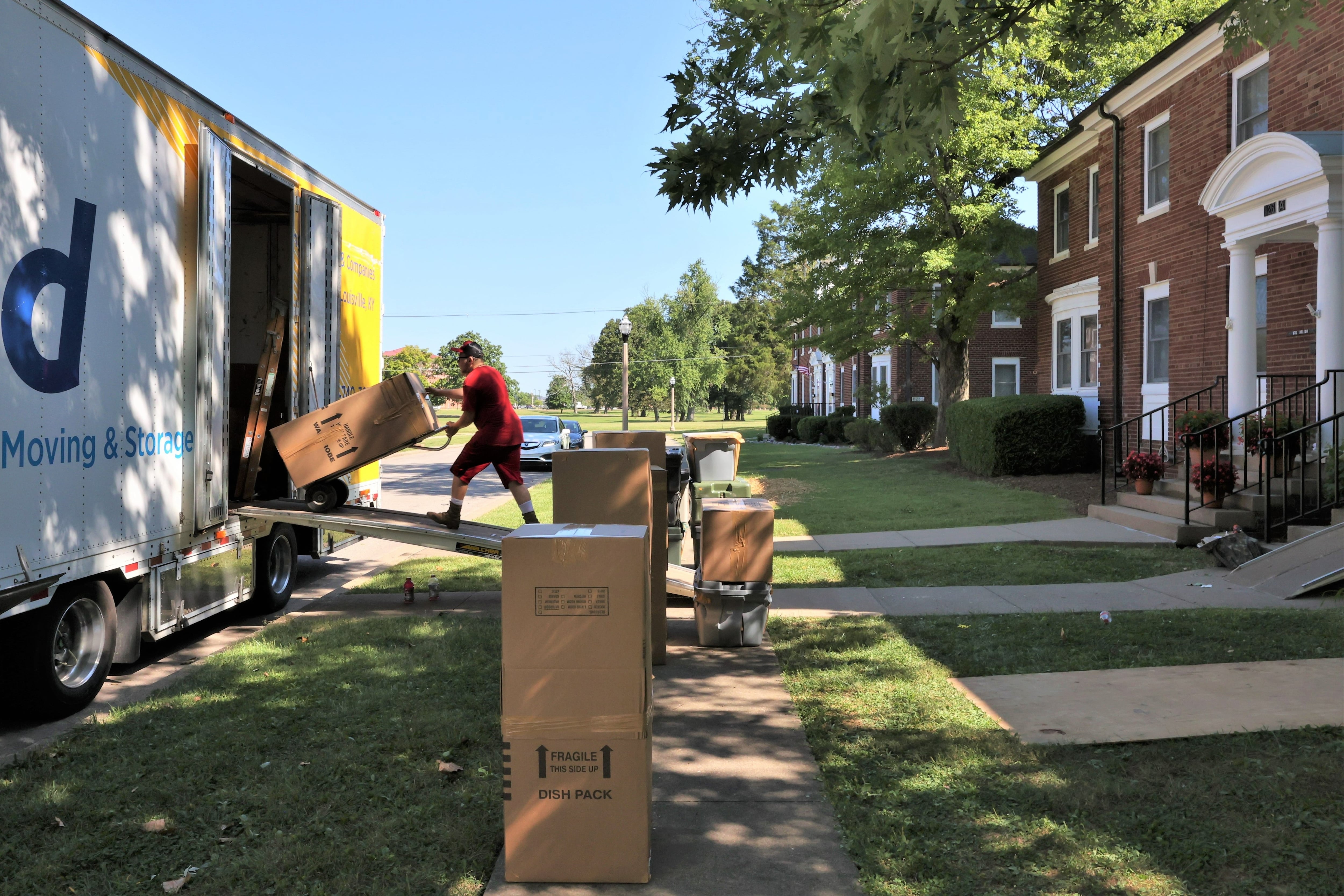Army wife Vanessa Seals, who was five months pregnant at the time, was forced to sleep on an air mattress for more than three weeks while her family waited for the delivery of their household goods at Hunter Army Airfield, Georgia.
“As you can imagine, it’s quite uncomfortable,” said Seals, mother of three young children ages 5, 3 and 14 months, on March 12. While the movers who packed and loaded their household goods at Fort Cavazos, Texas, on Feb. 19-20 were great, she said, “now the issue is waiting for our HHG to show up — we have no idea when that is going to be.”
The required delivery date was Feb. 28, and their mover, HomeSafe Alliance, told them they hadn’t found a driver to deliver their belongings, she said. Ten days later, on March 22, their household goods were finally delivered.
And this is early in the season. The busiest season for military moves is generally mid-May to mid-September.
With the military moving season bearing down on service members and their families, the prognosis for pickup and delivery of household goods is unclear. Much of it depends on the volume of military shipments and the capacity of movers to handle the load.
“The volume of shipments in the coming peak season ultimately depends on how many people the services are moving,” said Scott Ross, spokesman for U.S. Transportation Command, the Defense Department command in charge of the physical movement of service members’ belongings during a permanent change of station.
Following recent reports of issues with military moves, TRANSCOM officials no longer plan to fully transition all domestic shipments into the new Global Household Goods Contract, or GHC, by the April/May timeframe, as previously planned. The GHC contractor, HomeSafe Alliance, is handling the Seals family’s move.
TRANSCOM officials said they are adjusting their plan, but declined to specify how much they are reducing the number of moves that will be handled by HomeSafe.
The command will operate both programs — the legacy system and the GHC during the 2025 peak season, “and hold industry accountable in both,” Ross said. “This dual approach allows TRANSCOM to leverage capacity from both programs while also allowing HomeSafe the opportunity to improve their services.”
Members of the moving industry reported that more than 1,000 shipments were picked up by movers in the legacy system after the shipments were turned down by HomeSafe when it was unable to schedule movers, according to information provided March 13 by Movers for America, a coalition of moving professionals and independent owner-operators who move military families. The coalition has asked members of Congress for a pause in the implementation of the GHC.
The new GHC system, which began rolling out in April 2024, aims to fix long-standing problems with missed pickup and delivery dates, broken and lost items and issues with claims. It consolidates management under a single contractor, HomeSafe Alliance, which is responsible for overseeing all aspects of military families’ moves. TRANSCOM retains oversight of the program and holds HomeSafe accountable.
Under the legacy system, TRANSCOM works directly with more than 900 individual moving companies, making it difficult for the government to track and resolve issues. Those problems culminated in the summer of 2018, when moving companies didn’t have the capacity to handle the number of moves.
HomeSafe officials have acknowledged there have been some delays in moving families, related to the capacity of their network of moving companies. Some companies have been reluctant to do business with HomeSafe because its rates are lower than those under the legacy system.
Some families are feeling the effects of the delays both at the beginning of their move and at the end, when they are awaiting delivery.
An Air Force lieutenant colonel and his wife at Ellsworth Air Force Base, South Dakota, are among the military families who have felt the direct impact. More than a month after his move was awarded to HomeSafe, the company was still telling him “we are diligently working to find you a service provider,” said the officer, who asked to remain anonymous. He was in communication with his local transportation office at Ellsworth the entire time, which he describes as “awesome.”
At the beginning of March, about two weeks from his requested move date, his transportation office on base transferred the move back to the legacy system.
The Air Force and Army have issued notices to their transportation offices that any service members’ shipments that have no mover assigned with less than a 21-day lead time before the move must be pulled back into the legacy system.
The legacy system found a mover for the officer’s family. A moving company drove from Great Falls, Montana, to their home in Rapid City. “They’re loading today, so big win there — no thanks to HomeSafe or GHC,” the officer said on March 18.

Moving industry forecast
HomeSafe Alliance has made “significant progress” in strengthening its network of movers, and is pursuing “every available option for growing our capacity” for the next months of military moves, officials told Military Times.
It’s working with TRANSCOM to resolve issues and closely coordinating on a careful phase-in of the new program “to ensure a smooth peak moving season,” they said.
As for the broader universe of moving companies, some of which are doing business with both HomeSafe and the legacy system, there is uncertainty.
In general, moving companies are struggling a bit, because business across the board has been slow during the winter, said Dan Bradley, vice president of government and military relations for the International Association of Movers. But if the number of people moving in the DOD system is similar to what it’s been over the past two years, there shouldn’t be a capacity concern, certainly not in the legacy system, he said.
But there is uncertainty. TRANSCOM had previously touted its plan to move 100% of all domestic shipments under the GHC by the start of this year’s moving season, he said. Movers have been unsure how many people to hire for the summer or whether to buy more trucks, because they don’t know how business will be split between the legacy system and GHC, he said. There’s also uncertainty about whether TRANSCOM will reduce competitive rate ranges that affect what movers are paid under the legacy system. Those new rate ranges go into effect May 15.
“Movers are asking, ‘How far do I go right now to prepare for the summer, when I don’t have real good visibility of the landscape for the summer?’ ” Bradley said.
All this boils down to whether there will be enough movers to move military families this spring ans summer.
What military families can do
As soon as service members get orders to make a PCS move, they should visit Military OneSource, where they’ll find a variety of tips and instructions, and a link to start setting up their move. At that point, they will be put into either the HomeSafe Alliance system or the legacy system. They’ll either deal directly with HomeSafe, or with a moving company assigned by the legacy system.
A number of military families who described their experience said they’ve had trouble communicating with HomeSafe about the status of their shipment.
One soldier said he went through the system as soon as he received his orders in October 2024. HomeSafe completed his pre-move survey Feb. 7, but as of late March had yet to assign a moving company to pack and load his belongings ahead of his May 10 report date to Fort Irwin, California.
Communication with HomeSafe has been “horrible,” he said. “This will be my fifth PCS move, and I’ve never had to wait this long to find out who was moving my stuff.”
HomeSafe officials said they have addressed issues with communication to ensure service members get the timely updates they need. They’ve standardized communication between departments, improved their training program, and added more “proactive communication to customers throughout their moves.”
When service members are having any type of problem — regardless of who is moving them — they should contact their local transportation offices, Ross said.
HomeSafe advises service members to set up their HomeSafe Connect accounts as soon as possible after receiving an email with instructions for using the Okta user authentication system and HomeSafe Connect.
They also advise to:
* Update the destination address in HomeSafe Connect as soon as possible; when the shipment is ready for delivery, it will notify the service member.
* Have someone available at the residence — the service member or someone standing in — from 8 a.m. to 5 p.m. on all scheduled moving dates.
* Separate items such as medications, important documents, uniforms and other essential items, as well as jewelry and other valuables, to carry yourself. Place them in a separate, marked part of the house, or in a locked car, so they aren’t packed with the household goods shipment.
Those who experience delays should contact HomeSafe or their moving company to file an inconvenience claim. “When a claim is approved, we compensate the service member and each of their family members on the PCS order for every day that their move is delayed,” HomeSafe officials said.
While the services’ transportation offices are being watchful of these HomeSafe shipments, and pulling them back if HomeSafe can’t find a moving company within 21 days of a move, service members should be mindful and keep in touch with their transportation office if they haven’t been contacted by a company.
Cover your six
Regardless of who is moving you, take photos and videos of your household goods beforehand so that if something is lost or damaged, you have proof of their prior condition.
Before disposing of broken up or damaged belongings, check with your moving company or transportation office to see what evidence is needed for the claim to be substantiated.
One military wife who just began the moving process in March expressed the hopes of many for the busy moving season to come: “I am trying to stay positive with our PCS move this year as changes occur within the military system,” she wrote.
“As of now we are skeptical, but hopeful, things will turn out for the better with our move come this summer.”
Karen has covered military families, quality of life and consumer issues for Military Times for more than 30 years, and is co-author of a chapter on media coverage of military families in the book "A Battle Plan for Supporting Military Families." She previously worked for newspapers in Guam, Norfolk, Jacksonville, Fla., and Athens, Ga.





